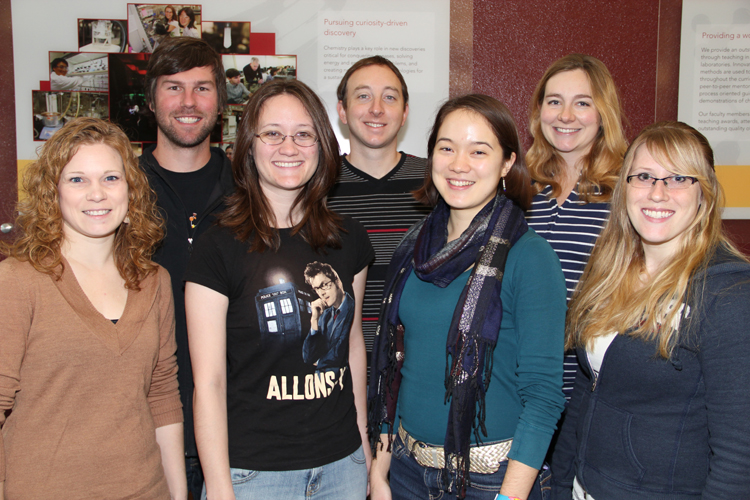

Main navigation | Main content
What began as a first-of-its-kind pilot safety initiative less than two years ago is now an embedded part of the culture of two departments in the College of Science & Engineering.
The Joint Safety Team (JST), which is led by graduate students and postdoctoral researchers in the departments of Chemistry and Chemical Engineering and Materials Science, continues to work hard on its efforts to improve and sustain the culture of safety in laboratories, including building safety awareness and improving safety practices. Its efforts are paying off with growing awareness, acceptance, compliance, and support. The success of this student-led initiative has gleaned university and national attention.
“It is going really well,” said Katherine “Katie” Hurley, a fourth-year graduate student in the Department of Chemistry and chair of the JST Administrative Committee. “Some of the barriers to safety have been removed. Safety is in the process of being adopted as a standard part of our culture,” she said.
The Joint Safety Team was formed more than a year and a half ago through a unique partnership with the Dow Chemical Company. The Dow Chemical Company is sharing its best-in-class laboratory safety practices, examples, advice, and resources with U of M students and postdoctorates.
Last fall, the JST launched a safety campaign focused on four key areas—CARE:
Hurley said that this safety campaign is making a difference. “People are really conscious about wearing the appropriate protective equipment in the labs; Safety Moments before all of our meetings are becoming routine; laboratory safety officers (LSOs) are more confident in their responsibilities; our laboratory inspections are now expected and accepted; and people are asking questions about safety,” she said.
One of the JST’s priority goals for 2014 is to develop and implement an incentive program designed to honor individuals and laboratories for their safety compliance and efforts. Dow Chemical Company also provided funds for new and additional safety posters that are strategically displayed in the hallways of the departments’ buildings.
Since its creation, it was hoped that what was learned from this pilot program would be shared with others at the University of Minnesota and other universities as well. Recently, the JST has been concentrating on such outreach at a variety of levels. Teams members have made presentations at the university and college levels and for other departments. They developed a comprehensive video about the JST and its work for Ohio State University. In January, Hurley will make a presentation about the JST and its initiatives at Duquesne University in Pennsylvania. In April, the JST will tell its story at a Materials Research Society meeting. Team members have also made presentations and demonstrations at schools, including the Chisago County Middle School Safety Camp.
The JST’s work could serve as a blueprint to help universities across the country change their safety cultures. Department of Chemistry Chair William Tolman testified about the composition and work of the Joint Safety Team at a National Research Council meeting. The National Research Council, through its Board on Chemical Science and Technology and Board on Human Systems Integration, is examining safety in academic research laboratories. It will publish and distribute its findings, conclusions, and recommendations for improving safety in the spring of 2014.
An article about this safety initiative was published in the Journal of Chemical Education (DOI:10.1021/ed400305e). The abstract for the article, “Student Involvement in Improving the Culture of Safety in Academic Laboratories,” reads: “An effective way of addressing the need for an improved culture of safety in research-intensive science departments is described, which involves enabling leadership by graduate student and postdoctoral associate laboratory safety officers (LSOs). In partnership with The Dow Chemical Company, LSOs from the Departments of Chemistry and Chemical Engineering and Materials Science at the University of Minnesota formed a Joint Safety Team. With helpful input from Dow, the team has played a key role in improving the culture and practice of safety in both departments, providing support for use of this model for inculcating safety as a core value and an integral part of academic life.”
“The unique approach we are taking is really catching the attention of other departments in the U.S.,” said Tolman. “We are changing the culture of safety, led by the very students and postdoctorates who spend the most time working in the laboratories.”
This safety initiative is hard work, but the approximately 65 members of the JST are highly committed. The JST is developing a new set of safety posters with financial support from the Dow Chemical Company; its leadership team continues to streamline its work; it continues to let students know, including incoming first-year graduate students, about expectations for safety; it provides safety information to everyone in both departments through its website; and it invites students and post doctorates who are interested to attend its meetings and become involved.
Other members of the JST Administrative Committee are Katie Peterson, treasurer, Ryan Knutson, website manager, Kelly Volp and Melissa Baudhuin, education and resources; and Chris Smith, public relations, who are all from the Department of Chemistry, and Alyssa McKenna, analysis and compliance, who is from the Department of Chemical Engineering and Materials Science. For additional information, send the JST an email at jst@umn.edu.
Members of the Joint Safety Team Administrative Committee are, from left, Katie Peterson, Ryan Knutson, Committee Chair Katherine “Katie” Hurley, Chris Smith, Alyssa McKenna (from the Department of Chemical Engineering and Materials Science), Research Safety Specialist Anna Sitek from the Department of Environmental Health and Safety, and Melissa Baudhuin.
